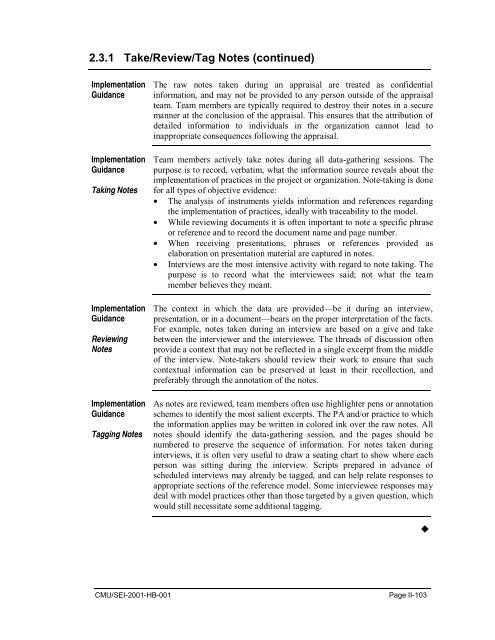Standard CMMI Appraisal Method for Process Improvement (SCAMPI)
Standard CMMI Appraisal Method for Process Improvement (SCAMPI)
Standard CMMI Appraisal Method for Process Improvement (SCAMPI)
You also want an ePaper? Increase the reach of your titles
YUMPU automatically turns print PDFs into web optimized ePapers that Google loves.
2.3.1 Take/Review/Tag Notes (continued)<br />
Implementation<br />
Guidance<br />
Implementation<br />
Guidance<br />
Taking Notes<br />
Implementation<br />
Guidance<br />
Reviewing<br />
Notes<br />
Implementation<br />
Guidance<br />
Tagging Notes<br />
The raw notes taken during an appraisal are treated as confidential<br />
in<strong>for</strong>mation, and may not be provided to any person outside of the appraisal<br />
team. Team members are typically required to destroy their notes in a secure<br />
manner at the conclusion of the appraisal. This ensures that the attribution of<br />
detailed in<strong>for</strong>mation to individuals in the organization cannot lead to<br />
inappropriate consequences following the appraisal.<br />
Team members actively take notes during all data-gathering sessions. The<br />
purpose is to record, verbatim, what the in<strong>for</strong>mation source reveals about the<br />
implementation of practices in the project or organization. Note-taking is done<br />
<strong>for</strong> all types of objective evidence:<br />
• The analysis of instruments yields in<strong>for</strong>mation and references regarding<br />
the implementation of practices, ideally with traceability to the model.<br />
• While reviewing documents it is often important to note a specific phrase<br />
or reference and to record the document name and page number.<br />
• When receiving presentations, phrases or references provided as<br />
elaboration on presentation material are captured in notes.<br />
• Interviews are the most intensive activity with regard to note taking. The<br />
purpose is to record what the interviewees said; not what the team<br />
member believes they meant.<br />
The context in which the data are provided—be it during an interview,<br />
presentation, or in a document—bears on the proper interpretation of the facts.<br />
For example, notes taken during an interview are based on a give and take<br />
between the interviewer and the interviewee. The threads of discussion often<br />
provide a context that may not be reflected in a single excerpt from the middle<br />
of the interview. Note-takers should review their work to ensure that such<br />
contextual in<strong>for</strong>mation can be preserved at least in their recollection, and<br />
preferably through the annotation of the notes.<br />
As notes are reviewed, team members often use highlighter pens or annotation<br />
schemes to identify the most salient excerpts. The PA and/or practice to which<br />
the in<strong>for</strong>mation applies may be written in colored ink over the raw notes. All<br />
notes should identify the data-gathering session, and the pages should be<br />
numbered to preserve the sequence of in<strong>for</strong>mation. For notes taken during<br />
interviews, it is often very useful to draw a seating chart to show where each<br />
person was sitting during the interview. Scripts prepared in advance of<br />
scheduled interviews may already be tagged, and can help relate responses to<br />
appropriate sections of the reference model. Some interviewee responses may<br />
deal with model practices other than those targeted by a given question, which<br />
would still necessitate some additional tagging.<br />
<br />
CMU/SEI-2001-HB-001<br />
Page II-103
















